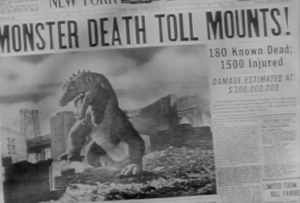
In case you haven’t noticed, I’m a fan of giant monster movies. If I were Emperor, I’d ram a law through the Imperial Senate making it a felony office to call yourself “a giant monster movie fan” without having seen this movie. You don’t have to like it, certainly, since it’s not very good. But the one thing it is beyond all else is influential. Without this film, there would be no Godzilla, no daikaiju genre as a whole. Beast from 20,000 Fathoms did for radioactive dinosaurs what Dracula did for vampires and King Kong did for giant apes. For that, I salute this film, and so should you.
If you want to understand why monster movies are what they are to day, seeing Beast is unavoidable. It’s an indispensable resource, a key to all the genre’s modern conventions. It brought the monster-on-the-loose movie forward, into a post-War age. And it did it all without even trying to do anything more than cash in on a the previous year’s re-release of King Kong.
First, we meet a standard Humble Narrator as he yammers on a bit about “Operation: Experiment.” It’s 1953, so the Pentagon’s yet to run out of obvious code names for its clandestine projects. Like this detonation of an atomic bomb “high above the Arctic Circle”…for some reason. Better than the middle of New Mexico, I suppose. No way Indiana Jones will accidentally wander into this test site. And even if he does, I’d like to see him find a fridge.
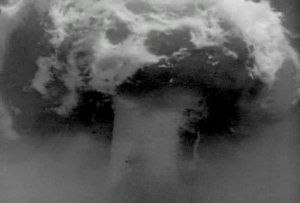
In the wake of the atomic blast, the radar men report a “foreign object” on their screen. Despite “silhouetting” at “five hundred tons at least,” the damn thing disappears before Colonel Jack Evans (Kenneth Tobey) can get a good look at it. That’d be enough foreshadowing for any film, but Beast from 20,000 Fathoms isn’t done with us yet, no sir!
We get a bit more, and a summation of our theme, from Professor Tom Nesbit (Paul Hubschmid, credited as “Paul Christian”) who will be our Heroic Scientist for the remainder of the film, just as Jack will be our Military Commander. These stock characters are Beast’s particular contribution to the genre, symptomatic of that brief, shinning moment, when American admiration for the Scientists and Generals who won World War II overcame our natural anti-intellectualism. This allowed Scientists to briefly become Heroes in their own right, so long as they tempered their scientific objectivity with pompous pronouncements like
Tom: What the cumulative effects of all these atomic tests and explosions can be only time will tell…the world’s been here for millions of years. Man’s been walking upright for a comparatively short time. Mentally, we’re still crawling. These tests will add to our knowledge, wouldn’t you say, Ritchie?
Ritchie: That’s right. Every time one of these goes off, I feel like we’re writing the first chapter in a new Genesis.
Tom: Let’s just make sure we’re not writing the last chapter of the old one.
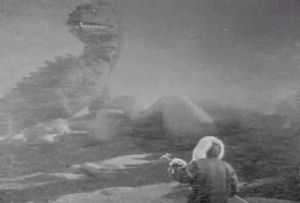
Oh boy. We’re in for it, now. So are Paul and Ritchie (Ross Elliott), who trek out onto the ice, leaving their military minders behind in the name of adding to their knowledge and allowing Eugène Lourié to rip-off The Thing from Another World on a $2.95 budget. Our two Scientists soon separate in the name of getting more work done. God soon illustrates why this is never a good idea by dropping a fucking dinosaur on poor, doomed Ritchie.
The sight startles him so badly he takes a pratfall down an ice canyon. Tom tries to rescue him but the Beast puts an end to that as well, burying Ritchie (and almost burying Tom) in a convenient avalanche. Shipped stateside due to his injuries, and with the only other witness dead, Tom’s left to convince the world atomic tests really did wake up a prehistoric monster, something we all take for granted now. Tom, though, has to deal with psychologists like Dr. Ingersoll (King Donovan) and their bullshit lines. Like,
“As a Scientist, it shouldn’t be inconceivable to you that the mind can withstand only so much pressure…it’s a phenomenon that was not uncommon during The War.”
Tom’s confinement to bed and rest leaves the Beast free to destroy fishing boats and lighthouses on its march down the eastern American seaboard. Such was the bifurcated view of Science in the mid-20th century. Some Scientists could be heroic, yes, under the right circumstances…but their dogmatic empiricism still killed as many people as it helped, if these movies are any indication. They aren’t. Instead, they’re modern recreations of a myth as old as monster myths themselves: the triumph of order over chaos.
Tom: What’s going on in our turbulent world today?
Tom’s Hot Nurse: Oh, death and politics. The comics page is the only thing that makes sense any more.
Tom: I take it that, for peace of mind, you recommend a dose each week?
Tom’s Hot Nurse: You quote me, exactly.
[And now you know why I found her so hot.]
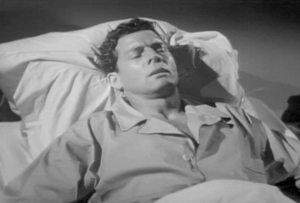
What more potent and obvious symbol of chaos than a nuclear explosion? No wonder it wakes up sea serpents (as one headline calls our Beast) from epochal slumbers, cracking the boundaries between our mundane, orderly world, and the primordial disorder that gave birth to it. A chaos that could easily swallow it back up…unless some Hero steps in to slay the Dragon and vanquish evil.
Tom, our twentieth century St. George, goes directly to New York University’s Department of Paleontology, and its head, Prof. Thurgood Elson (Cecil Kellaway). Here we see the Elder Scientist, older even than Van Helsing, and quick to quash any quack notions from the younger, Bomb-creating generation. The Elder Scientist sees crack notions as his exclusive domain, because he alone has the power (of seniority) to make them sound reasonable to the public. Witness the refinements of this archetype in Them!‘s Dr. Harold Medford and Gojira‘s Dr. Yamane. Witness, too, the mid-century expansion of that most-hated of all stock characters, The Chick.
Here represented by Lee Hunter (Paula Raymond), The Chick’s allowed to breathe in ways King Kong didn’t have time for, rising from Archetype Land to become an actual, honest-to-God character. Not a very good one, but at least she’s a bit more than her ability to scream. (By the 50s, she could serve coffee as well.) After Dr. Elson sends Tom packing, it’s Lee who rescues him from doubting his own sanity. Not that she believes his whole “prehistoric monster” story…at first. But she saw him give a lecture on the “medical benefits of radioactive isotopes,” years ago, and no one so “brilliant” could possibly be mad…right? (Someone must not be a fan of horror movies. More fool her.)
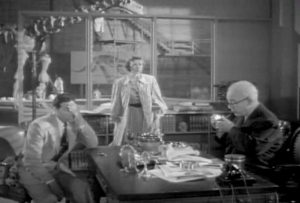
Right. So as soon as Tom’s back at work (at the Atomic Energy Commission’s N.Y. Regional Office), Lee’s there to extend a come-up-and-see-me-sometime invitation. “I have a deep, abiding faith in the work of Scientists,” Lee says, illustrating another bit of cultural schizophrenia. “Otherwise I wouldn’t be one myself.” Besides, her look says, your lectures gave me a girl-boner. Over coffee, the two set the stage for their cinematic descendants by picking Tom’s monster out of a stack of dinosaur pictures.
This type of scene grinds the plots of other monster movies to a halt, but Lourié (shocker of shockers) uses the time to develop his character’s relationships. You don’t see Ishiro Honda squatting on his character’s shoulders during shot-reverse-shot conversations, and he’d certainly never have allowed his heroine’s leg (discretely clad in a flowing, ankle-length dress, but still) to brush up against his hero’s shoulder. For the conventions of the time, Tom and Lee’s little mug shot search is uncomfortably intimate. There’s a French New Wave-y feeling to watching these two young unmarrieds that’s quietly nice.
We finally get back to it after Tom picks the (fictional) Rhedosaurus out of Lee’s line-up. This picture, and the testimony of a Canadian fisherman the Beast attacked between character bits, convinces Dr. Elson to phone up Tom’s old Army buddy, Colonel Evans. The man Tom calls “Jack” like they grew up next door to each other reluctantly agrees to keep an ear out for monster news.
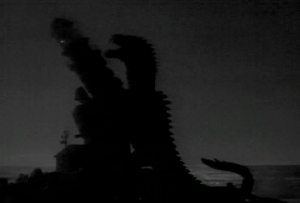
Wonder of wonders, Jack actually does, requesting updates from his good friend in the Coast Guard, Capt. Phil Jackson (Donald Woods). So when the Beast destroys a lighthouse in homage to the Ray Bradburry short story that originally inspired this flick, all our main characters hear about it.
Vindication’s an exciting thing. I won’t try to deny that. But Our Hero, Prof. Tom, seems extraordinarily happy for someone who watched a giant monster bury his colleague under an avalanche half a movie ago. All I’m saying is, from the size of the grin he sports through this back half of this flick, the hospital must’ve sent him home with some serious anti-depressants.
At least Dr. Elson can use his dedication to Science as an excuse for suddenly being stupid. Thanks to this, Elson decides to beg a diving bell off the Coast Guard and go exploring the Hudson River’s expansive underwater canyons…which it totally has, you guys. For real. Since the only known Rhedosaurus fossils came out of these riverbeds, Elson theorizes the Beast is heading back to its ancestral home. He turns out to be fatally correct, dying as he lived: describing the monster in Bullshit Latin. (After he describes a stock footage fight between a shark and an octopus…because the Hudson River totally has those, too)
Enough padding. Enough character development. Enough talking about stuff no one really talks about when they review these movies. Time for what really made this film famous: the Beast’s attack on New York City. It’s another sequence that would go on to be Xeroxed by every hack who ever tried his hand at the genre. From Bert I. Gordon to Steven Spielberg, they’ve all copied this movie’s fleeing population, bombastic, chilling score, and gratuitous deaths of ancillary characters we could give a fuck about. Out of all those who’ve tried to recreate this film’s level of daikaiju carnage, only Ishiro Honda managed to surpass it.
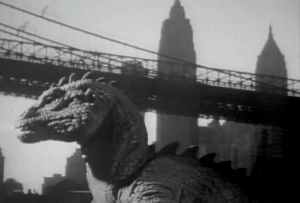
Here’s where the movie critic inevitably gives credit for that to famed stop motion animator Ray Harryhausen, a Willis O’Brien protege who used the strength of this film to escape his mentor’s shadow and establish himself as The Man. Many regard this Rhedosaurus as his best work, with good reason. I’m not one of them, but I see where they’re coming from – after all, the Beast says “Fuck the police,” in ways NWA could only dream of – but this film didn’t have the budget for Harryhausen to really show off. In fact, money was so tight, Harryhausen had to teach himself split-screen rear-projection to get the quality of effects he wanted, and there’s a romanticism to that story I rather like. That’s how we get to see the Beast framed against the Brooklyn Bridge, or rip apart the roller coaster at “the Manhattan Beach Amusement Park.” (Played by the Long Beach Amusement Park between the hours of 10 p.m. and 3 a.m.) All of it as seamlessly integrated as it could afford to be one a budget of two hundred thousand 1953 dollars.
I’m not joking. This was a quick cheapy, and it shows. That, more than anything, is why the film waits fifty-seven minutes before getting to the so-called “good” part. No modern monster movie would dare drag out the whole “no one believes the one person who saw the monster” bit for so long. It gives Lourié a chance to build up some Love Interest between his leads that doesn’t feel as forced or obligatory as it would otherwise…and deploy a tactical squad of wacky, French Canadian incidental characters. Shame they never get any real press.
Then there’s the ending, which is abrupt as all hell, with a weak-ass resolution and a one-scene denouement. After punching through its skin with a mortar shell, the Army discovers the Beast’s blood is chock full of deadly, ancient pathogens. So much for conventional weapon, eh? Tom even rules out flame throwers because smoke carries germs as easily as wind…right, you guys…? Our Scientist, ladies and gentlemen.
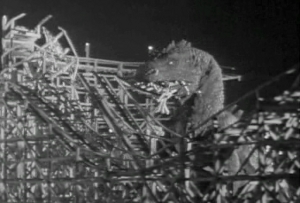
The movie has to rule out flame throwers. Otherwise, Tom would have no reason to remind us he’s a nuclear physicist, by God, that most heroic of Heroic Scientists. Thanks to this, he has all the resources at hand to burn the Beast up from the inside out, including just the right radioactive isotope. Convenient, no?
Making things worse, Tom’s isotope comes pre-weaponized, allowing a young Lee Van Cleef (no, really) to load it into a rifle. There’s some false tension when the two decide to climb up the roller coaster, since Van Cleef can’t make the shot from the ground. Whatever, we all know they’re going to win. The script’s just dragging this out. Van Cleef makes the shot, the Beast’s death throes inadvertently trigger an explosion, Our Heroes escape, Tom and Lee (no, not Van Cleef, the Lee we’ve spent the rest of the movie with) share a hug, the Beast slumps over dead, the End. What, you’re still here? It’s over!
Our Heroes don’t even get the courtesy Earth vs. The Flying Saucers would pay to its Scientist and Chick three years later. They ended things on a goddamn beach, staring off into a climactic sunset. Lee and Tom end up staring into their monster’s funeral pyre. It’s the 50s, so not only does Dr. Frankenstein get to live, he gets to watch his monster die a slow and agonizing death while The Girl clings to his arm. God damn, Scientists had it good back then.
I don’t think I need to tell you how you could get a whole movie out of a monster’s attack on New York, especially if the monster’s blood packs a virulent insta-plague. Seriously, it downs people in seconds, making certain zombie viruses look like layabout goldbrickers. And it comes out of nowhere five minutes before the end of the flick. Do I even need to mention how bad of an idea that is? Who the hell brings up such major plot points five minutes before the credits?

In that sense, this movie’s a perfect template for its genre. It starts out with a constantly ratcheting level of tension, sprinkled with iconic sequences of ship and lighthouse destruction. The middle of the film will drive you mad if you don’t care about the characters, but if you do, you’ll find plenty of fun bits sprinkled throughout. (Paul Hubschmid’s Swiss accent is comedy gold all by itself.) The Beast’s rampage through New York is its real high point and, after the bombastic pronouncements from the Plot Specific News Network, the movie can’t really top itself. It doesn’t end so much as stop, leaving the audience to go and get their own goddamn catharsis.
It’s like Lourié didn’t know what tone to go for, and considering Beast‘s four screenwriters (Robert Smith, Lou Morheim, Fred Freiberger and Lourié himself, plus Daniel James, who goes uncredited) that’s not really a surprise. But we’ve seen worse done with more, so let this movie stand as an object lesson in what you can do if you’ve got talent to make up for your lack of resources. It’s the rare American daikaiju piece that actually deserves its classic status. If nothing else I’ve mentioned peaked your interest, check it out for that alone…though, if nothing I’ve said peaked your interest, I obviously haven’t done my job. If that’s true then I need to re-up on anti-depressants. Where’s my comics page, damnit? And where’s my hot, comics page-reading nurse?
![]()
![]()
![]()
![]()
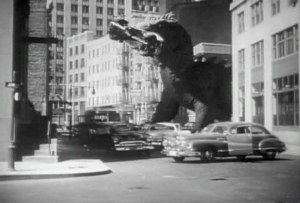

I should probably watch this one again; I caught it about 3 years ago for the first time, and watching monster movies for something like 28 years, then seeing this one, the source of so many cliches and so beloved, was a bit anti-climatic. One thing I do know: it beats the hell out of the filmmaker’s own follow up, The Giant Behemoth.
True dat. I was lucky enough to find – or, at least, find out about – this thing at an early age, when I picked one of those old movie trailer compilation tapes out of the bargain bin at Wal-Mart. I think I was six or seven…young enough to actually pay money for a trailer compilation, at any rate. And in the middle of things (right after the trailer for The Thing from Another World, in fact) I saw this
Well, that does it, seven-year-old me figured, launching himself into a quest. And, after raiding every electronics store in a fifty mile radius, I found my old VHS copy of this and a lot more besides. (Gorgo, King Kong vs. Godzilla, 20 Million Miles to Earth…).
I get the anti-climactic feelings, though. Seven-year-old me would’ve gotten them, too. By that point he’d watched far too many of the Godzilla movies (over and over again) readily available at his local video rental store. He had gain a historical perspective, an interest in telling stories, and an interest in tracing those story’s evolution through the popular mediums of our time, before he could really see the magic in this silly little flick.
Oh, I think 5 or 6 year old me had read about this film in one of the little orange monster movie books my school library (and maybe my town library) had. Wonderful things. Unfortunately that meant I just saw a bunch of stills, plus my older brother’s assurance that it was one of his favorite ones. Sometimes I need to see these things a second time after the stink of disappointment wears off. (Not always, though; Destroy All Monsters, for example, is as unsatisfying today as when I finally saw it at 18, after 14 fruitless years trying to get a copy of the film I saw on a Saturday afternoon one time)
The tale of the Little Orange Monster Books in the School Library, and their impact on fan dom as a whole, has yet to be written. But I suspect that, if you scratch a certain generation of us hard enough, you’ll find plenty of people with the same general story. For a brief, glorious time, my library boasted Frankenstein, Dracula, The Wolf Man (which spoiled all the Universal horror classics for me years before I actually got to see any of them) and, incongruously but fortuitously, Godzilla.
What? You guys missed the real treat of seeing this as a first run drive-in flick. Sitting down front on a blanket in a hot summer night in Alabama with all the kids in the neighborhood that could be packed into Daddy’s car. Eating hot dogs and rooting for the monster (and the popcorn). Of course we knew the world would never be the same – we were born with the Bomb. You’re right – I need to watch this again. Thanks.
As ever, you’re right. And you’re welcome.
I liked the virus-in-the-blood plot point, clumsily introduced though it was. It lets the Rhedosaurus be vulnerable to military grade weaponry, but prevents the characters from exploiting this by providing a reason why they can’t spray the dinosaur’s guts all over New York with cannon fire, because it’ll spread the disease. …. As opposed to just making it inexplicably invulnerable to anti tank rounds for no reason like many later giant monsters.
No good “in-story” reason, at least. American kaiju are aspects of Fear, whatever the Fear of the moment might be (Atomic in the 50s; environmental in the 70s; bio-technological today) and, as such, vulnerable to human weapons. Japanese daikaiju are invulnerable (for the most part) because they are the physical aspect of those devastating-but-natural forces that created Home Islands in the first place. Both are, however, vulnerable to Super Science…or used to be, back when humanity had some confidence in itself and its future.